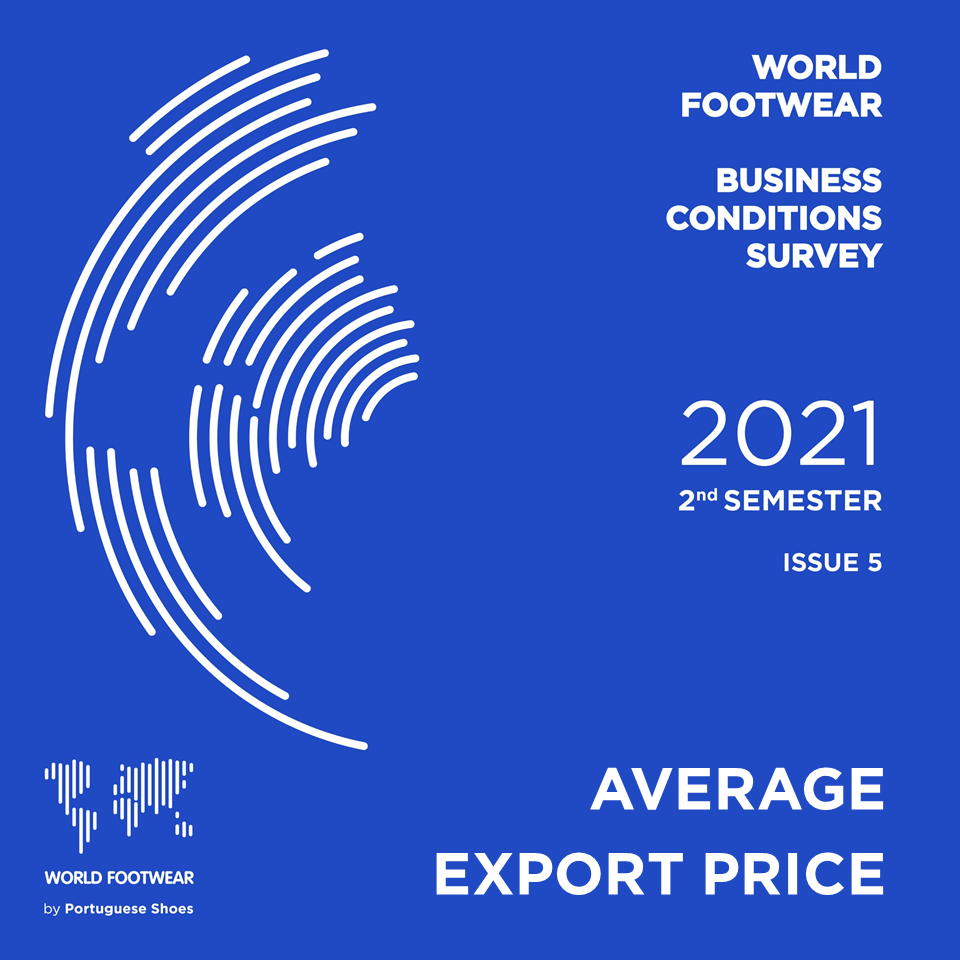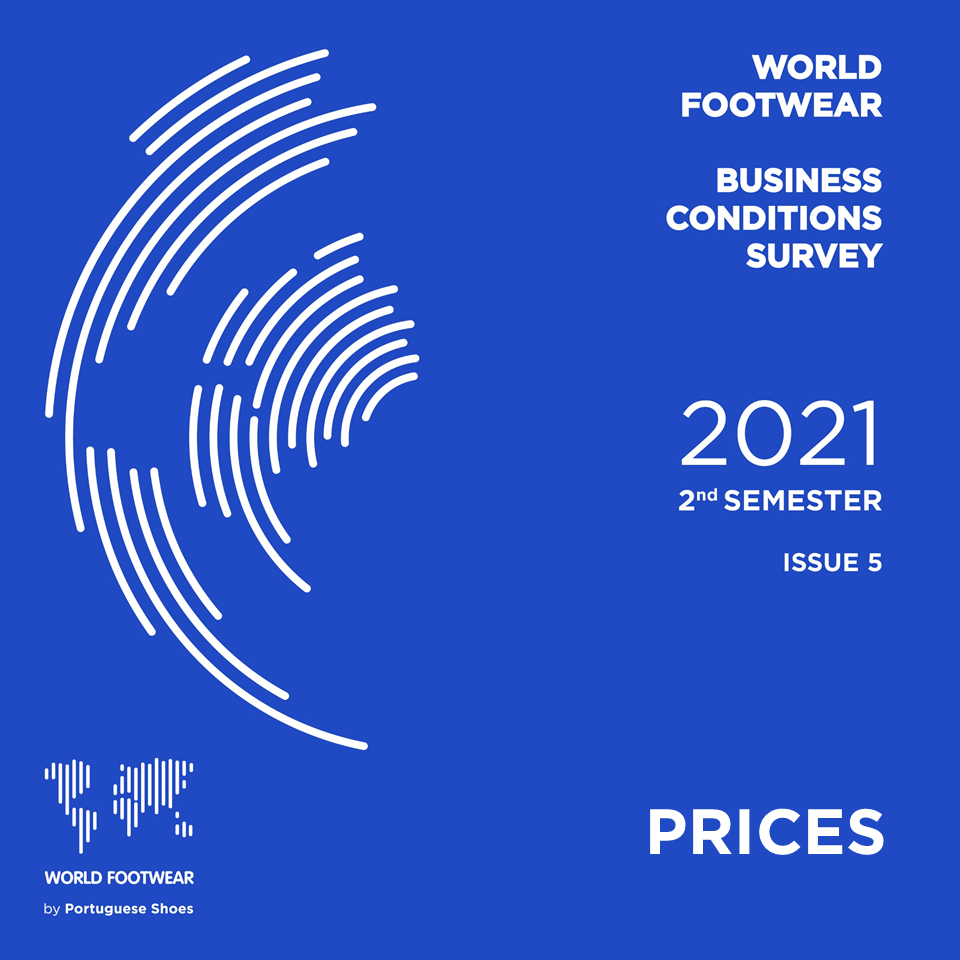Register to continue reading for free
Footwear prices on growing mode

The overall increase in prices, associated with the disruptions in the supply chain we have come to know since the beginning of the COVID-19 pandemic, has been on the agenda for quite some time now. This trend affects necessarily the footwear industry across the entire supply chain, from suppliers of raw materials to final consumers. We have identified the key pointers that allow us to have a better understanding of this worldwide increase.
World Footwear Business Conditions Survey
In the last decade, the average price of footwear exported worldwide increased from 7.75 US dollars to 10.37 US dollars a pair, which reflects a rise of 33.8%. It is quite a figure considering that, in the prior decade, the average price of footwear had only increased by less than half, that is, 16.4%.Data from the Business Conditions Survey (more information available HERE) that we have conducted allows us to suggest that this trend will continue in coming years across several geographies: in median, experts expect the average export price to reach 12.35 US dollars by 2025.
Among the 122 surveyed experts, more than three quarters expect prices to increase (77%), while only 3% believe they will decrease; the remaining are betting on a stabilization (20%). The sentiment is common to respondents operating in every line of businesses. Geographically, Asia and Africa respondents are slightly more cautions regarding perspectives on the evolution of prices.
Cost of Merchandise or Raw Materials
The expectation in price increases is being driven by the upward pressure in the cost of materials. According to our Business Conditions Survey, 84% of the respondents have identified the cost of raw materials as one of the three main difficulties for the next six months. The average price of raw materials has significantly increased since last March.This can be explained by the global supply chains disruptions, started by the pandemic, which created shortages and increased costs. In addition, new virus outbreaks and responding lockdowns in some parts of the world are scaling down production.
At the beginning of the pandemic, most commodities had a price drop thanks to the natural decline of demand, which forced companies in the production sector to reduce supply to balance prices. The reality has significantly changed in recent months. Currently, demand is growing, but companies producing commodities (such as metal extraction, energy or agricultural production) are unable to meet it because they had to reduce their productive capacity to endure the hardest periods of the pandemic.
The Bloomberg Commodity Index shows that the current average price of raw materials reached 27.21%. The pre-pandemic index corresponded to 22%.
Transportation Costs
The rise in the price of energy, together with supply chain disruptions worldwide, led to a spike in transportation costs in the last months. The cost of shipping has increased by more than 520% since the beginning of the COVID-19 pandemic (shipping a 40-foot container from China to Europe costed 2 000 US dollars and costs now, in average, more than 6 000 US dollars). Air transport has also increased by almost 200%.
Wage Costs
Minimum wage costs might come to play an important role in the near future. On one hand, an ever-rising wave of wage can hinder companies’ profits, which are vital to improve long-run economic growth. On the other hand, if productivity rises, then wage growth need not cause sustained inflation or increase labour costs. However, the pandemic has introduced a series of changes in the labour world, and productivity statistics are not yet clear.According to the CNCB , twenty-six of the US states will raise their minimum wage in 2022. Workers have been pushing to earn 15 US dollars per hour. However, only California and parts of New York will mandate hourly pay of at least 15 US dollars. Moreover, many workers will benefit from substantial pay increases because their employers chose to raise it on their own. The COVID-19 pandemic seems to have brought a new awareness for hourly workers and low wages.
China is currently undergoing a minimum wage hike. Nikkei Asia has pointed out that 20 out of 31 provincial-level regions have increased their minimum wage over 2021. Guangdon Province, which is China’s largest province by economic size, has raised its monthly minimum wages in November from 1 410 yuan (around 222 US dollars) to 2 200 yuan (around 350 US dollars) to be between 1 620 yuan (around 255 US dollars) and 2 360 yuan (around 370 US dollars). It was the first increase in the province since July 2018. President Xi Jinping call for “common prosperity” in late August has accelerated the trend.
Higher wages may, however, drive businesses away. Labour costs are already higher in China than in many Southeast Asian countries. A survey of the Japan External Trade Organization shows that Japanese companies pay ordinarily manufacturing workers in China an average base salary of 531 US dollars a month (in 2020), as compared with 447 US dollars in Thailand or 250 US dollars in Vietnam. Moreover, the majority of ASEAN (Association of Southeast Asian Nations) countries minimum wages remain significantly lower than those in the developed economies of the world.
The consultancy Oxfords Economics has found out that underlaying wage growth is at about 2.5% across the G10 group of large economies, and as fast as it was in 2018. Specifically, underlaying pay rise is growing three times more quickly in Anglo-Saxon countries than in continental European countries.
Inflation
In November 2021, the Euro zone recorded a rate of inflation of 4.9%, quite above the average value recorded between 2015 and 2020 (by 0.9%). In the US, inflation accelerated at its fastest pace since 1982 in November, reaching to 6.8% last November.The exception has been the Asia region, where inflation has remained more moderate, as compared to other regions. Among several factors, which may help us explain this, are the delayed recovery of emerging Asian economies and the contrast felt regarding the energy inflation. The region has experienced more muted energy inflation than Europe and the US.
According to the International Monetary Fund, “broad inflationary pressures will eventually moderate globally, as supply-demand mismatches ease and stimulus recedes”. However, in 2022, “as the recovery strengthens, the persistent impact of high shipping costs could put an end to the benign inflation Asia has enjoyed in 2021”. The experts of IMF observe that “increases in shipping costs boost inflation for 12 months, which could add about 1.5 percentage points to the pace of Asia’s inflation in the second half of 2022”.
Footwear consumption
Let us return to our Business Survey. Despite the uncertainty brought by the increase in prices, 42% of the respondents expect moderate growth in footwear consumption to between 1.5% and 5% in 2022, as compared to the 2019 pre-Covid levels. On average, experts expect a growth of 2.0% in the global consumption of footwear, in pairs, in 2022.Image Credits: glamour.com







